Batsheva Dance Company, live and on film, performs in New York.
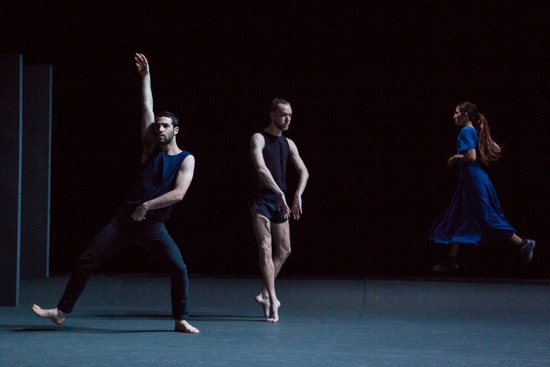
Or Meir Schraiber (L) and William Barry of Batsheva Dance Company in Ohad Naharin’s Last Work. At back: Rani Lebzelter. Photo: Yi-Chun Wu
The Brooklyn Academy of Music’s Howard Gilman Opera House is packed —the orchestra, the first balcony, the second balcony, all. The curtain rises, and thousands of eyes converge on a single person moving through time, frozen in space. On top of a slightly raised platform that crosses the back of the stage, a woman is running on an invisible treadmill. Wearing sneakers and a simple, full-skirted, royal blue dress (not your usual workout attire), she runs easily and at a moderate pace, focused on whatever is ahead of her. After a few minutes, closer to us, a man enters through one of the many openings in an array of white panels. He faces the same way she’s facing, but he’s walking slowly and deliberately. In a squat. Once he reaches the center of the stage, he rises, looks at us over his shoulder, and, holding one of his legs by the knee, he makes that leg turn in and out, faster and faster, until you almost see a wave between it and his shoulder. This is not a typical dance gesture; it’s a job, a preoccupation.
The woman is still running.
Another man arrives. Tall and lean, he quivers and undulates, working his body as if he were a snake gulping down a rabbit, yet also precise in how he manages his limbs. A woman enters and stands close to the front of the stage, her arms folded. The tall man leaves, and she melts into an extraordinary private task. It’s not just that she very slowly unfolds a leg straight into the air, but that some kind of disturbance—or process— under her skin begins to make her body the site of small, sinuous eruptions. She seems almost boneless, and infinitely resourceful in that bonelessness. Another man enters and, arms folded, stares at her.
The woman is still running.
These extraordinarily gifted people are, in order of appearance, Rani Lebzelter, Or Meir Schraiber, William Barry, Nitzan Ressler, and Matan Cohen, some of the eighteen members of Israel’s Batsheva Dance Company. Welcome to artistic director Ohad Naharin’s Last Work. As he has explained, the title doesn’t mean that the piece is the last work he’ll ever make, only that it’s the most recent one that he has created.
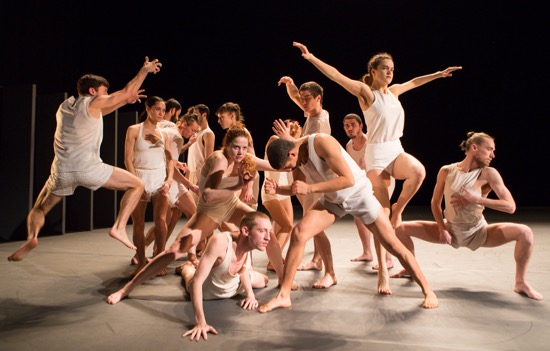
Members of Bathsheva Dance Company in Ohad Naharin’s Last Work. Closest to the camera (L to R): Bret Easterling (jumping), Zina (Natalya) Zinchenko, Kyle Scheurich (on floor), Ori Moshe Ofri, Yael Ben Ezer, and William Barry. Photo: Yi-Chun Wu
At some point you understand that Lebzelter is probably going to run for the approximately 70 minutes that Last Work will last. She becomes a marker. You check her periodically for the slightest signs of fatigue. She’s going nowhere; she’s surviving. We’re all okay.
Over the course of the piece—to a fine atmospheric score by Grischa Lichtenberger, with stage design by Zohar Shoef, costumes by Eri Nakamura, and subtly changeable lighting by Avi Yona Bueno (Bambi)—the dancers exhibit strength, clarity, decisiveness, fearlessness, and a kind of ferocity, but also that uncanny flexibility to which the choreographer has gradually introduced us. These people can move as if their muscles were knitted of elastic thread, as if their joints were greased daily. The technique that Naharin has invented, and that has shaped them into the remarkable dancers that they are, is called Gaga. In a discussion that followed a special showing at BAM of the film Mr .Gaga (it runs at Film Forum through February 16th and in Lincoln Center’s Eleanor Bunin Monroe Film Center through February 9th), Naharin mentioned his interest in the ways in which traditionally masculine movement responses coexist with the feminine in all bodies, regardless of gender. Batsheva dancers may spread their legs wide and hunker down in attack mode or walk delicately on tiptoe. Pressed together, their fingers jab the air; released, they may flutter. Watching Zina (Natalya) Zinchenco travel to a new spot on the floor while sitting on the floor her legs in a split, you may think, “Why would anyone want to do that?” And then you think of animals and the animal in all of us.
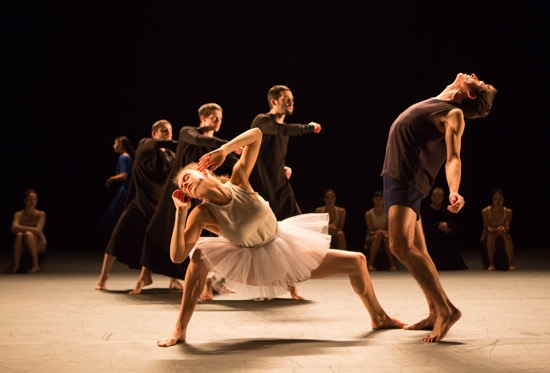
Ohad Naharin’s Last Work. Foreground: Yael Ben Ezer (L) and Bret Easterling. Behind them (L to R): Yoni Simon, Matan Cohen, and Or Meir Schraiber. Photo: Yi-Chun Wu
Mr. Gaga: A True Story of Love and Dance, —a sensitive and revealing film directed by Tomer Heymann and produced by his brother Barak that took eight years to complete—brings out things that I have felt before about Naharin’s work. He spent his childhood in Kibbutz Mizra, one of a bunch of kids growing up together, and, to me, the dancers in his works almost always appear as members of a community. They watch one another, take turns, step in and join, support or ignore.
When, in Last Work, they go to the back of the stage and slip out of one set of clothes into white ones resembling underwear, you can think of Naharin’s obligatory stretch in the Israeli Army, as part of a band entertaining troops during the 1973 Yom Kippur War. He saw the aftermath of combat. Some of the remarkable footage that the Heymann brothers found and used in their film intersperse a shot of bodies littering an expanse of ground with ones of Naharin and his comrades conferring. And in Last Work, the still moments after dancers have fallen resonates with that fact, even though the choreographer is not telling a linear narrative.
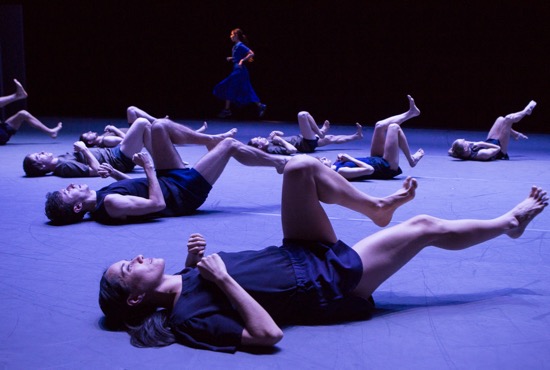
Members of Batsheva Dance Company in Last Work, Rachael Osbourne nearest camera. At back, running: Rani Lebzelter. Photo: Yi-Chun Wu
In an interview with Gia Kourlas that appeared in the New York Times, Naharin mentioned three images that he had given the dancers during the choreographic process, inviting them to embody one or more of them: “baby,” “ballerina,” and “executioner.” How he then manipulated and developed those remains a mystery, but you can be reminded of a baby’s instability in the performers’ occasional knock-kneed staggers, even though such images dissolve or blend into something else. For instance, shortly after a sweet, deep voice sings a Romanian lullaby, they lie still as what sounds like a train cohabits with deep, plucked strings and mingled voices; then, lying on their backs, they kick and wiggle their legs every which way, like infants. This action, however, formalizes and speeds up, until it seems that the performers are running while lying down—tilted versions of Lebzelter in her blue dress.
Fellowship sometimes appears obligatory—for instance, when the performers march along in an orderly group—although throughout the piece, contentious or amicable or erotic encounters crop up. On the other hand, what they are undergoing can seem private, whether they are simply glancing at the sky or, whether, motivated from forces without or within, they are arching uncannily far back and hanging there for seconds before either twisting into something new or collapsing to the floor.
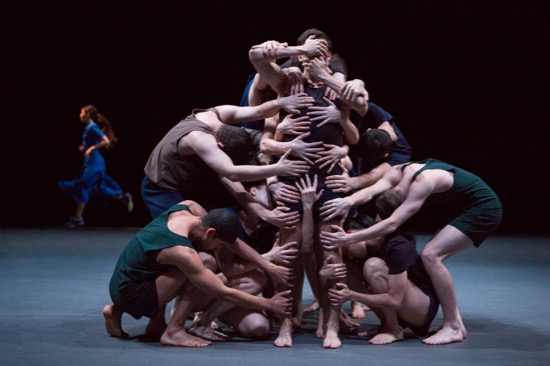
Batsheva Dance Company. Bret Easterling surrounded, Rani Lebzelter running. Photo: Yi-Chun Wu
We recognize the everyday in movements that are anything but ordinary. Rachael Osbourne kneels on Ian Robinson’s chest, but seconds later, he is copying her as she walks around on tiptoe; then they’re dancing in perfect synchrony; then, they’re holding hands and yanking apart. None of this seems arbitrary. Nor should you make firm cause-and-effect connections between Maayan Sheinfeld’s outburst of body-shattering motion and the fact that the men who have been watching her (Bret Easterling, Ori Moshe Ofri, and Robinson) put their arms around one another and take off running together. It’s uncanny when clustering performers enwrap Easterling in such a manner that he is invisible behind their hands, but you don’t stop to consider whether they are barricading him or protecting him. Nor do you wonder what forces have caused Easterling and Yael Ben Ezer (the tallest of the women) to begin a duet collapsed, their heads on each other’s shoulders.
Often when more than a few people are onstage, your eyes travel around, taking in this person or that one, drawn to a burgeoning encounter. You notice everyone (in addition to those already mentioned: Omri Drumlevitch, Hsin-Yi Hsiang, Eri Nakamura, Kyle Scheurich, and Yoni Simon).
Last Work escalates in intensity near the end. The music is louder, more explosive. Robinson becomes a somewhat desperate figure of authority. He uses plastic tape to anchor the microphone into which he sings to the floor. Confetti shoots up from a formerly concealed rifle. Then he rushes around, using far more tape than seems necessary to attach the scattered others to one another,—clumsily corseting them, binding them for extra security. As they sink down, shaking, he gives Lebzeiter (yes, still running) a white flag to bear. A high voice sings. The others just sit there staring as the curtain comes down.
After the work is over, I feel as if I’ve been through something with these people, even if I can’t put that feeling into words. Last Work makes me think of Israel today, of America, and elsewhere. Of uncertainty and danger and individual bravery. And enough wit to get through the day.
,
